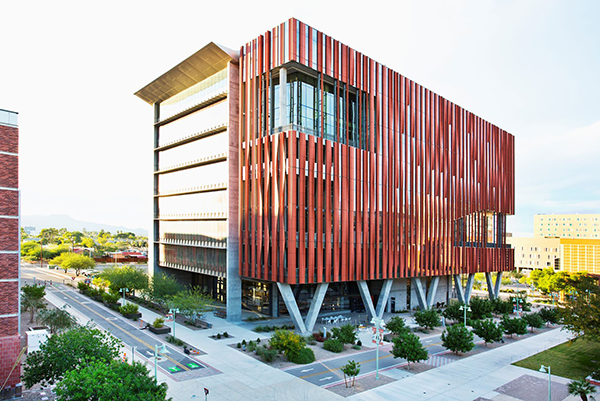University of Arizona’s New Glass-Covered Building Consolidates its Health Sciences Programs into One Building

With strips of terracotta panels and expansive glazed curtainwall, the new 230,000-square-foot Health Sciences Innovation Building (HSIB) at the University of Arizona features a ground-floor forum, daylit student lounges and study spaces, simulation laboratories, and more.
Consolidating the University’s medicine, nursing, pharmacy and public health departments into one building, the only glass capable of meeting CO Architects’ performance, cost, availability and aesthetic goals was Vitro's Solarban 90 Starphire glass. “Solarban 90 Starphire glass was ultimately chosen for its high-performance, neutral cool coloration and relatively low reflectivity as well as the flatness of the glass,” says Arnold Swanborn, AIA, LEED AP, design principal, CO Architects, Los Angeles.
About Solarban 90 Starphire
Solarban 90 glass conveys an appearance like clear glass in both color and reflectance, whether viewed from either the interior or exterior of a building. Since Solarban 90 glass doesn’t display a noticeably reflected color, it can be paired with Starphire Ultra-Clear glass by Vitro to provide enhanced levels of aesthetics and performance. When paired with ordinary clear glass in a 1-inch insulating glass unit (IGU) Solarban 90 glass provides visible light transmittance (VLT) of 51 percent and a solar heat gain coefficient (SHGC) of 0.23. When paired in a 1-inch IGU with Starphire Ultra-Clear glass, it provides VLT of 54 percent.
The design of the building
Carefully considering the surrounding desert and urban context along with the intense Arizona heat, each building elevation has its own carefully calibrated design. For the east elevation, the architects created the building’s terracotta design for shading and to blend in with the Sonoran Desert surroundings. Taking its cue from the local saguaro cactus and its ability to self-shade, CO Architects designed twisted, vertical terracotta panels in an adobe dark red. The panels are attached to a Solarban 90 Starphire glass curtainwall. In between the panels and curtainwall are a couple of porch areas with outdoor patio space for students.
For both the north and south exposures, the façade is curtainwall. Individually tuning both elevations to minimize heat gain and glare, the south side is fritted and incorporates sunshade and the north curtainwall contains fins. In response to the harsh sun on the west side, glass is minimized. The design is comprised of a series of narrow and deep canyons to limit the amount of time the sun is directly hitting the glass. The windows are no more than 7 to 8 inches wide, with an approximate 2:3 width-to-depth ratio.
A major feature at the HSIB is a large, column-free amphitheater-style space where students gather for events, presentations, and individual and/or group study. “The forum is conceived as the living room of the building,” says Swanborn. “It’s a place where students from the four health sciences colleges can mingle, connect, study, eat and share in this town square of sorts.”
Because natural lighting and visual connection were very important for this space, a recessed glass design provides this while creating shade and eliminating direct sun exposure to the glass. The recessed design enabled the architects to go without low-e glass for this portion of the building. This greatly increased VLT while significantly lowering reflectivity.
Starphire Ultra-Clear glass by Vitro provides an option for curtainwall glass applications, offering clarity and true-to-life views of the outdoors. A 1/8-inch thick lite of Starphire Ultra-Clear glass provides a VLT of 91% to infuse interiors with vibrant daylight.
The glass is set on steel horizontal ledges, with no verticals, to maximize the site lines while working with standard glass sizes. On the forum’s north side, the glass opens by way of large hydraulic Starphire glass garage doors that allow the interior to extend into an exterior-shaded patio.
A large, open staircase offers daylighting and views, encouraging students and staff to take the stairs all the way up to the ninth floor. Floors three through six house classrooms and student support spaces. The seventh floor holds the Arizona Simulation Technology & Education Center with a black-box theater and simulation deck providing an immersive simulation environment. On the eighth floor, 30 exam rooms support inter-professional education and clinical skills practice. The office space on the top floor incorporates a slanted roof and clerestory windows glazed with Solarban 90 Starphire glass.
“Glass-fronted offices are carefully arranged parallel to the light monitor and separated by open work areas to ensure each occupant and office space has a sense of time and benefits from indirect daylight and view,” says Swanborn.

